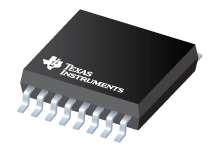Datasheet Texas Instruments TPS61131PWR — Datenblatt
| Hersteller | Texas Instruments |
| Serie | TPS61131 |
| Artikelnummer | TPS61131PWR |

3,3 V, 90% effizienter SEPIC-Wandler mit 3,3 V, 200 mA LDO für 1-Zellen-LiIon- oder Dual-Cell-Anwendungen 16-TSSOP -40 bis 85
Datenblätter
TPS6113x Synchronous SEPIC and Flyback Converter With 1.1-A Switch and Integrated LDO datasheet
PDF, 1.2 Mb, Revision: C, Datei veröffentlicht: Sep 29, 2015
Auszug aus dem Dokument
Preise
Status
| Lifecycle Status | Active (Recommended for new designs) |
| Manufacture's Sample Availability | No |
Verpackung
| Pin | 16 |
| Package Type | PW |
| Industry STD Term | TSSOP |
| JEDEC Code | R-PDSO-G |
| Package QTY | 2000 |
| Carrier | LARGE T&R |
| Device Marking | PS61131 |
| Width (mm) | 4.4 |
| Length (mm) | 5 |
| Thickness (mm) | 1 |
| Pitch (mm) | .65 |
| Max Height (mm) | 1.2 |
| Mechanical Data | Herunterladen |
Parameter
| Approx. Price (US$) | 1.63 | 1ku |
| Duty Cycle(Max)(%) | 100 |
| Iq(Typ)(mA) | 0.04 |
| Operating Temperature Range(C) | -40 to 85 |
| Package Group | TSSOP |
| Rating | Catalog |
| Regulated Outputs(#) | 2 |
| Special Features | Enable Light Load Efficiency Load Disconnect Power Good |
| Switch Current Limit(Min)(A) | 1.1 |
| Switch Current Limit(Typ)(A) | 1.3 |
| Switching Frequency(Max)(kHz) | 600 |
| Switching Frequency(Min)(kHz) | 400 |
| Type | Converter |
| Vin(Max)(V) | 5.5 |
| Vin(Min)(V) | 1.8 |
| Vout(Max)(V) | 3.3 |
| Vout(Min)(V) | 3.3 |
Öko-Plan
| RoHS | Compliant |
| Pb Free | Yes |
Design Kits und Evaluierungsmodule
- Evaluation Modules & Boards: TPS61130EVM-206
TPS61130 Evaluation Module
Lifecycle Status: Active (Recommended for new designs)
Anwendungshinweise
- Minimizing Ringing at the Switch Node of a Boost ConverterPDF, 201 Kb, Datei veröffentlicht: Sep 15, 2006
The application report explains how to use proper board layout and/or a snubber to reduce high-frequency ringing at the switch node of a boost converter. - Basic Calculation of a Boost Converter's Power Stage (Rev. C)PDF, 186 Kb, Revision: C, Datei veröffentlicht: Jan 8, 2014
This application note gives the equations to calculate the power stage of a boost converter built with an IC with integrated switch and operating in continuous conduction mode. It is not intended to give details on the functionality of a boost converter (see Reference 1) or how to compensate a converter. See the references at the end of this document if more detail is needed. - Optimizing Transient Response of Internally Compensated DC-DC Converters (Rev. A)PDF, 1.1 Mb, Revision: A, Datei veröffentlicht: May 11, 2015
- Optimizing Resistor Dividers at a Comparator (Rev. A)PDF, 120 Kb, Revision: A, Datei veröffentlicht: Jun 3, 2013
- Choosing an Appropriate Pull-up/Pull-down Resistor for Open Drain OutputsPDF, 130 Kb, Datei veröffentlicht: Sep 19, 2011
- Extending the Soft Start Time Without a Soft Start Pin (Rev. B)PDF, 387 Kb, Revision: B, Datei veröffentlicht: Jun 15, 2017
- IQ: What it is what it isn’t and how to use itPDF, 198 Kb, Datei veröffentlicht: Jun 17, 2011
- Performing Accurate PFM Mode Efficiency Measurements (Rev. A)PDF, 418 Kb, Revision: A, Datei veröffentlicht: Dec 11, 2018
When performing measurements on DC-DC converters using pulse frequency modulation(PFM)or any power save mode proper care must be taken to ensure that the measurements are accurate. An accurate PFM mode efficiency measurement is critical for systems which require high efficiency at low loads such as in smart home systems tablets wearables and metering.
Modellreihe
Serie: TPS61131 (2)
- TPS61131PW TPS61131PWR
Herstellerklassifikation
- Semiconductors > Power Management > Non-isolated DC/DC Switching Regulator > Step-Up (Boost) > Boost Converter (Integrated Switch)